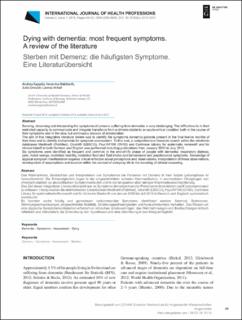Please use this identifier to cite or link to this item:
https://doi.org/10.21256/zhaw-3535Full metadata record
| DC Field | Value | Language |
|---|---|---|
| dc.contributor.author | Koppitz, Andrea Luise | - |
| dc.contributor.author | Waldboth, Veronika | - |
| dc.contributor.author | Dreizler, Jutta | - |
| dc.contributor.author | Imhof, Lorenz | - |
| dc.date.accessioned | 2018-03-15T14:33:35Z | - |
| dc.date.available | 2018-03-15T14:33:35Z | - |
| dc.date.issued | 2015 | - |
| dc.identifier.issn | 2296-990X | de_CH |
| dc.identifier.uri | https://digitalcollection.zhaw.ch/handle/11475/3944 | - |
| dc.description.abstract | Sensing, observing and interpreting the symptoms of persons suffering from dementia is very challenging. The difficulties lie in their restricted capacity to communicate and irregular transitions from a chronic-stable to an acute-critical condition both in the course of their symptoms and in the slow but continuous process of deterioration. The aim of this integrative literature review was to identify the symptoms dementia patients present in the final twelve months of their lives and to identify instruments for symptom assessment. To this end, a comprehensive literature search within the electronic databases Medline® (PubMed), Cinahl® (EBSCO), PsycINFO® (OVID) and Cochrane Library for systematic reviews® and for clinical trials® in both German and English was performed including publications from January 2000 to July 2012. Six symptoms were identified as frequent and common in the end-of-life phase of people with dementia: respiratory distress, pain, mood swings, restricted mobility, restricted food and fluid intake and behavioural and psychosocial symptoms. Knowledge of atypical symptom manifestation requires critical reflection about perceptions and observations, interpretation of these observations, development of assumptions and location within the context of everyday life in the meaning of clinical reasoning. Das Wahrnehmen, Beobachten und Interpretieren von Symptomen bei Personen mit Demenz in ihrer letzten Lebensphase ist herausfordernd. Die Schwierigkeiten liegen in der eingeschränkten verbalen Kommunikation, in wechselnden Übergängen von chronisch-stabilen zu akut-kritischen Symptomverläufen und in der langsamen aber stetigen Krankheitsverschlechterung. Das Ziel dieser integrativen Literaturübersicht war es Symptome demenzerkrankter Personen in ihren letzten zwölf Lebensmonaten zu erfassen. Hierzu wurden die elektronischen Datenbanken Medline® (PubMed), Cinahl® (EBSCO), PsycINFO® (OVID), Cochrane Library für systematische Reviews® und für klinische Studien® von Januar 2000 bis Juli 2012 in Deutsch und Englisch systematisch durchsucht. Es konnten sechs häufig und gemeinsam vorkommenden Symptome identifiziert werden: Atemnot, Schmerzen, Stimmungsschwankungen, eingeschränkte Mobilität, Ernährungsschwierigkeiten und herausforderndes Verhalten. Das Wissen um eine atypische Symptommanifestation erfordert ein klinisches Urteilsvermögen, das Wahrnehmungen und Beobachtungen kritisch reflektiert und interpretiert, die Entwicklung von Hypothesen und eine Einordnung in den Alltag ermöglicht. | de_CH |
| dc.language.iso | en | de_CH |
| dc.publisher | De Gruyter | de_CH |
| dc.relation.ispartof | International Journal of Health Professions | de_CH |
| dc.rights | http://creativecommons.org/licenses/by-nc-nd/4.0/ | de_CH |
| dc.subject | Sympom | de_CH |
| dc.subject | Dementia | de_CH |
| dc.subject | Dying | de_CH |
| dc.subject | Assessment | de_CH |
| dc.subject.ddc | 616.8: Neurologie und Krankheiten des Nervensystems | de_CH |
| dc.title | Dying with dementia: most frequent symptoms : a review of the literature | de_CH |
| dc.title.alternative | Sterben mit Demenz: die häufigsten Symptome : eine Literaturübersicht | de_CH |
| dc.type | Beitrag in wissenschaftlicher Zeitschrift | de_CH |
| dcterms.type | Text | de_CH |
| zhaw.departement | Gesundheit | de_CH |
| dc.identifier.doi | 10.21256/zhaw-3535 | - |
| dc.identifier.doi | 10.1515/ijhp-2015-0003 | de_CH |
| zhaw.funding.eu | No | de_CH |
| zhaw.issue | 1 | de_CH |
| zhaw.originated.zhaw | Yes | de_CH |
| zhaw.pages.end | 63 | de_CH |
| zhaw.pages.start | 49 | de_CH |
| zhaw.publication.status | publishedVersion | de_CH |
| zhaw.volume | 2 | de_CH |
| zhaw.publication.review | Peer review (Publikation) | de_CH |
| zhaw.webfeed | Angewandte Gerontologie | de_CH |
| zhaw.funding.zhaw | Pain Intervention for people with dementia in nursing homes (PID) | de_CH |
| Appears in collections: | Publikationen Gesundheit | |
Files in This Item:
| File | Description | Size | Format | |
|---|---|---|---|---|
| 2015_Koppitz_dying_with_dementia.pdf | 1.49 MB | Adobe PDF |  View/Open |
Show simple item record
Koppitz, A. L., Waldboth, V., Dreizler, J., & Imhof, L. (2015). Dying with dementia: most frequent symptoms : a review of the literature. International Journal of Health Professions, 2(1), 49–63. https://doi.org/10.21256/zhaw-3535
Koppitz, A.L. et al. (2015) ‘Dying with dementia: most frequent symptoms : a review of the literature’, International Journal of Health Professions, 2(1), pp. 49–63. Available at: https://doi.org/10.21256/zhaw-3535.
A. L. Koppitz, V. Waldboth, J. Dreizler, and L. Imhof, “Dying with dementia: most frequent symptoms : a review of the literature,” International Journal of Health Professions, vol. 2, no. 1, pp. 49–63, 2015, doi: 10.21256/zhaw-3535.
KOPPITZ, Andrea Luise, Veronika WALDBOTH, Jutta DREIZLER und Lorenz IMHOF, 2015. Dying with dementia: most frequent symptoms : a review of the literature. International Journal of Health Professions. 2015. Bd. 2, Nr. 1, S. 49–63. DOI 10.21256/zhaw-3535
Koppitz, Andrea Luise, Veronika Waldboth, Jutta Dreizler, and Lorenz Imhof. 2015. “Dying with Dementia: Most Frequent Symptoms : A Review of the Literature.” International Journal of Health Professions 2 (1): 49–63. https://doi.org/10.21256/zhaw-3535.
Koppitz, Andrea Luise, et al. “Dying with Dementia: Most Frequent Symptoms : A Review of the Literature.” International Journal of Health Professions, vol. 2, no. 1, 2015, pp. 49–63, https://doi.org/10.21256/zhaw-3535.
Items in DSpace are protected by copyright, with all rights reserved, unless otherwise indicated.